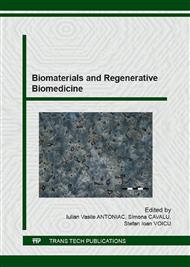p.260
p.267
p.273
p.278
p.284
p.289
p.295
p.303
p.309
Naturally Derived Matrix for Controlled Selenium Nanoparticles Delivery
Abstract:
The aim of this study is to develop a lyophilized matrix (microspheres) as a controlled delivery system for nanoselenium particles, using different formulation based on alginate or agar. Elemental selenium is considered as the least toxic of all selenium forms and in the same time supplementation with its nanosize particles has the same or better bioavailability compared to its salts. In our study, nanosized elemental selenium was obtained by fermentation technology using probiotic lactic acid bacteria (Lactobacillus casei). The microspheres have been characterized from structural point of view by using different techniques: FTIR spectroscopy, X-ray Diffraction and SEM. Each individual natural polymer has its own characteristic advantages and disadvantages; it is commonly accepted that naturally derived matrix often show an excellent balance between the mechanical properties, swelling and dissolution capacity. The optimized formulation was proposed upon in vitro dissolution study using Diferential Pulsed Voltammetry in order to measure the concentration of selenium released in simulated gastric fluid (pH=1.2) and simulated intestinal fluid (pH=8.1). The cumulative release of selenium from different formulations showed large differences with respect to matrix composition. We demonstrated that both alginate and agarose-based formulations are suitable to be used in basic environment such as small or large intestine. The results might be of high importance as absorption of selenium occurs mainly in the duodenum, caecum and colon (more than 85%).
Info:
Periodical:
Pages:
284-288
Citation:
Online since:
May 2016
Authors:
Keywords:
Price:
Сopyright:
© 2016 Trans Tech Publications Ltd. All Rights Reserved
Share:
Citation:


